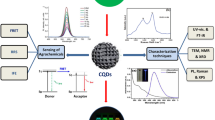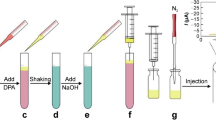Abstract
Histamine is one of the biogenic amines, which plays a vital role in the neurotransmission processes, regulation of gastrointestinal, circulatory, and inflammatory reactions in the human systems. It is also found more frequently in the spoiled food, particularly fish and fishery items. Thus, histamine determination is very important for biomedical application and food quality assurance. Here, we report a mediator and promoter-free electrochemical histamine sensor developed using visible light exposed tungsten trioxide (WO3) nanoparticles as sensing material. WO3 NPs irradiated for different exposition periods were characterized using XRD, UV–visible spectroscopy, and electrochemical methods. The WO3 NPs irradiated for 8 h exhibited significant changes in the structural, electrical, and electrochemical properties when compared to the non-irradiated samples. The cyclic and differential pulse voltammetry (DPV) studies carried out on irradiated WO3-modified glassy carbon electrode exhibited an excellent electrocatalytic ability toward the oxidation of histamine in phosphate buffer saline (PBS, pH 6.0). DPV studies revealed that the developed sensor has higher sensitivity over a wide linear concentration range from 1 nM to 1 mM with the lowest detection limit of 0.17 nm. The major impediment with the histamine sensing in real samples is the interference caused by other biogenic amines and biomolecules with structural similarity to histamine. The present sensor based on WO3 nanoparticles exhibited high selectivity toward histamine in the presence of several potentially interfering substances such as biogenic amines (cadaverine, putrescine, dopamine, and serotonin), amino acids (cysteine, phenylalanine, histidine, tryptophan, and tyrosine) and other biomolecules (glucose, ascorbic acid, uric acid), cations (Na+, K+ and Ca2+), and anions (Cl−, NO3− and SO42−). The fabricated sensor was successfully applied to determine the histamine content in vinegar sample.
Graphic abstract











Similar content being viewed by others
Data availability
All the data and the material are included in the manuscript itself.
Code availability
Not applicable.
References
Parsons ME, Ganellin CR (2006) Histamine and its receptors. Br J Pharmacol 147(S1):S127–S135
Harsing LG Jr, Nagashima H, Duncalf D, Vizi ES, Goldiner PL (1986) Determination of histamine concentrations in plasma by liquid chromatography/electrochemistry. Clin Chem 32(10):1823–1827
von Mach-Szczypiński J, Stanosz S, Sieja K, Stanosz M (2009) Metabolism of histamine in tissues of primary ductal breast cancer. Metabolism 58(6):867–870
Amorim CG, Souza RC, Araújo AN, Montenegro MC, Silva VL (2010) SI lab-on-valve analysis of histamine using potentiometric detection for food quality control. Food Chem 122(3):871–876
Önal A (2007) A review: current analytical methods for the determination of biogenic amines in foods. Food Chem 103(4):1475–1486
Pérez S, Bartrolí J, Fàbregas E (2013) Amperometric biosensor for the determination of histamine in fish samples. Food Chem 141(4):4066–4072
Maintz L, Novak N (2007) Histamine and histamine intolerance. Am J Clin Nutr 85(5):1185–1196
Latorre-Moratalla ML, Veciana-Nogués T, Bover-Cid S, Garriga M, Aymerich T, Zanardi E, Ianieri A, Fraqueza MJ, Patarata L, Drosinos EH, Laukova A (2008) Biogenic amines in traditional fermented sausages produced in selected European countries. Food Chem 107(2):912–921
Venugopal V (2002) Biosensors in fish production and quality control. Biosens Bioelectron 17(3):147–157
Rauscher-Gabernig E, Grossgut R, Bauer F, Paulsen P (2009) Assessment of alimentary histamine exposure of consumers in Austria and development of tolerable levels in typical foods. Food Control 20(4):423–429
Degefu H, Amare M, Tessema M, Admassie S (2014) Lignin modified glassy carbon electrode for the electrochemical determination of histamine in human urine and wine samples. Electrochim Acta 121:307–314
Chen HC, Huang YR, Hsu HH, Lin CS, Chen WC, Lin CM, Tsai YH (2010) Determination of histamine and biogenic amines in fish cubes (Tetrapturus angustirostris) implicated in a food-borne poisoning. Food Control 21(1):13–18
Chow CF, Lam MH, Wong WY (2013) Design and synthesis of heterobimetallic Ru (II)–Ln (III) complexes as chemodosimetric ensembles for the detection of biogenic amine odorants. Anal Chem 85(17):8246–8253
Ayesh AM, Ibraheim MN, El-Hakim AE, Mostafa EA (2012) Exploring the contamination level by biogenic amines in fish samples collected from markets in Thuel Saudi Arabia. Afr J Microbiol Res 6(6):1158–1164
Awan MA, Fleet I, Thomas CP (2008) Determination of biogenic diamines with a vaporisation derivatisation approach using solid-phase microextraction gas chromatography–mass spectrometry. Food Chem 111(2):462–468
Peeters M, Csipai P, Geerets B, Weustenraed A, Van Grinsven B, Thoelen R, Gruber J, De Ceuninck W, Cleij TJ, Troost FJ, Wagner P (2013) Heat-transfer-based detection of l-nicotine, histamine, and serotonin using molecularly imprinted polymers as biomimetic receptors. Anal Bioanal Chem 405(20):6453–6460
Itoh Y, Oishi R, Nishibori M, Saeki K (1991) Characterization of histamine release from the rat hypothalamus as measured by in vivo microdialysis. J Neurochem 56(3):769–774
Sarada BV, Rao TN, Tryk DA, Fujishima A (2000) Electrochemical oxidation of histamine and serotonin at highly boron-doped diamond electrodes. Anal Chem 72(7):1632–1638
Stojanović ZS, Švarc-Gajić JV (2011) A simple and rapid method for histamine determination in fermented sausages by mediated chronopotentiometry. Food Control 22(12):2013–2019
Geto A, Tessema M, Admassie S (2014) Determination of histamine in fish muscle at multi-walled carbon nanotubes coated conducting polymer modified glassy carbon electrode. Synth Metals 191:135–140
Gumpu MB, Nesakumar N, Sethuraman S, Krishnan UM, Rayappan JB (2014) Development of electrochemical biosensor with ceria–PANI core–shell nano-interface for the detection of histamine. Sens Actuators B 199:330–338
Veseli A, Vasjari M, Arbneshi T, Hajrizi A, Švorc Ľ, Samphao A, Kalcher K (2016) Electrochemical determination of histamine in fish sauce using heterogeneous carbon electrodes modified with rhenium (IV) oxide. Sens Actuators B 228:774–781
Stojanović ZS, Mehmeti E, Kalcher K, Guzsvány V, Stanković DM (2016) SWCNT-modified carbon paste electrode as an electrochemical sensor for histamine determination in alcoholic beverages. Food Anal Methods 9(10):2701–2710
Akhoundian M, Rüter A, Shinde S (2017) Ultratrace detection of histamine using a molecularly-imprinted polymer-based voltammetric sensor. Sensors 17(3):645
Leonardo S, Campàs M (2016) Electrochemical enzyme sensor arrays for the detection of the biogenic amines histamine, putrescine and cadaverine using magnetic beads as immobilisation supports. Microchim Acta 183(6):1881–1890
Pietrzyk A, Suriyanarayanan S, Kutner W, Chitta R, D’Souza F (2009) Selective histamine piezoelectric chemosensor using a recognition film of the molecularly imprinted polymer of bis (bithiophene) derivatives. Anal Chem 81(7):2633–2643
Keow CM, Bakar FA, Salleh AB, Heng LY, Wagiran R, Bean LS (2007) An amperometric biosensor for the rapid assessment of histamine level in tiger prawn (Penaeus monodon) spoilage. Food Chem 105(4):1636–1641
Yadav S, Nair SS, Sai VV, Satija J (2019) Nanomaterials based optical and electrochemical sensing of histamine: progress and perspectives. Food Res Int 119:99–109
Anithaa AC, Lavanya N, Asokan K, Sekar C (2015) WO3 nanoparticles based direct electrochemical dopamine sensor in the presence of ascorbic acid. Electrochim Acta 167:294–302
Anithaa AC, Asokan K, Sekar C (2017) Highly sensitive and selective serotonin sensor based on gamma ray irradiated tungsten trioxide nanoparticles. Sens Actuators B 238:667–675
Anithaa AC, Asokan K, Sekar C (2017) Voltammetric determination of epinephrine and xanthine based on sodium dodecyl sulphate assisted tungsten trioxide nanoparticles. Electrochim Acta 237:44–53
Anithaa AC, Asokan K, Sekar C (2017) Swift heavy nickel ion irradiated ethylene diamine tetra acetic acid-assisted tungsten trioxide thin film for the electrocatalytic detection of guanine. Sens Actuators B 247:814–822
Anithaa AC, Asokan K, Sekar C (2018) Low energy nitrogen ion beam implanted tungsten trioxide thin films modified indium tin oxide electrode-based acetylcholine sensor. J Taiwan Inst Chem Eng 84:11–18
Garza-Arévalo JI, García-Montes I, Reyes MH, Guzmán-Mar JL, Rodríguez-González V, Reyes LH (2016) Fe doped TiO2 photocatalyst for the removal of As (III) under visible radiation and its potential application on the treatment of As-contaminated groundwater. Mater Res Bull 73:145–152
Cazzanelli E, Vinegoni C, Mariotto G, Kuzmin A, Purans J (1999) Low-temperature polymorphism in tungsten trioxide powders and its dependence on mechanical treatments. J Solid State Chem 143(1):24–32
Venkateswarlu K, Sandhyarani M, Nellaippan TA, Rameshbabu N (2014) Estimation of crystallite size, lattice strain and dislocation density of nanocrystalline carbonate substituted hydroxyapatite by X-ray peak variance analysis. Procedia Mater Sci 5:212–221
Laviron E (1979) General expression of the linear potential sweep voltammogram in the case of diffusionless electrochemical systems. J Electroanal Chem Interfacial Electrochem 101(1):19–28
Funding
Authors acknowledge CSIR [Grant No. 03(1419)/18/EMR-II dated: 04.06.2018] and MHRD-RUSA 2.0 [Grant No. F.24-51/2014-U, Policy (TN-Multi-Gen), dated: 09.10.2018], DST-PURSE [Grant No. Phase 2/38(G) dated: 21.02.2017] for financial assistance.
Author information
Authors and Affiliations
Contributions
CS: Conceptualization, Supervision, Reviewing and Editing. ACA: Methodology, data curation, Writing- Original draft preparation and Investigation. GV: Methodology, Re-writing, data curation. SBMV: Methodology, data curation.
Corresponding author
Ethics declarations
Conflict of interest
The authors declare that they have no known competing financial interests or personal relationships that could have appeared to influence the work reported in this paper.
Additional information
Publisher's Note
Springer Nature remains neutral with regard to jurisdictional claims in published maps and institutional affiliations.
Supplementary Information
Below is the link to the electronic supplementary material.
Rights and permissions
About this article
Cite this article
Anithaa, A.C., Mayil Vealan, S.B., Veerapandi, G. et al. Highly efficient non-enzymatic electrochemical determination of histamine based on tungsten trioxide nanoparticles for evaluation of food quality. J Appl Electrochem 51, 1741–1753 (2021). https://doi.org/10.1007/s10800-021-01608-3
Received:
Accepted:
Published:
Issue Date:
DOI: https://doi.org/10.1007/s10800-021-01608-3




